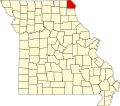Clark County | |
|---|---|
 Clark County Courthouse in Kahoka | |
 Location within the U.S. state of Missouri | |
 Missouri's location within the U.S. | |
| Coordinates: 40°25′N91°44′W / 40.41°N 91.74°W | |
| Country | |
| State | |
| Founded | December 16, 1836 |
| Named after | William Clark |
| Seat | Kahoka |
| Largest city | Kahoka |
| Area | |
• Total | 512 sq mi (1,330 km2) |
| • Land | 505 sq mi (1,310 km2) |
| • Water | 7.1 sq mi (18 km2) 1.4% |
| Population (2020) | |
• Total | 6,634 |
| • Density | 13.1/sq mi (5.07/km2) |
| Time zone | UTC−6 (Central) |
| • Summer (DST) | UTC−5 (CDT) |
| Congressional district | 6th |
| Website | https://clarkcountymo.org/ |


Clark County is a county located in the U.S. state of Missouri. As of the 2020 census, its population was 6,634. [1] Its county seat is Kahoka. [2] The county was organized December 16, 1836, and named for William Clark, leader of the Lewis and Clark Expedition and later Governor of Missouri Territory. [3] [4]
Contents
- History
- Geography
- Adjacent counties
- Major highways
- National protected area
- Demographics
- 2020 census
- 2010 census
- Education
- Public schools
- Private schools
- Public libraries
- Communities
- Cities
- Villages
- Census-designated places
- Other unincorporated places
- Townships (all inactive)
- Politics
- Local
- State
- Federal
- See also
- References
- External links
Clark County is part of the Fort Madison – Keokuk, IA-IL-MO Micropolitan Statistical Area.
